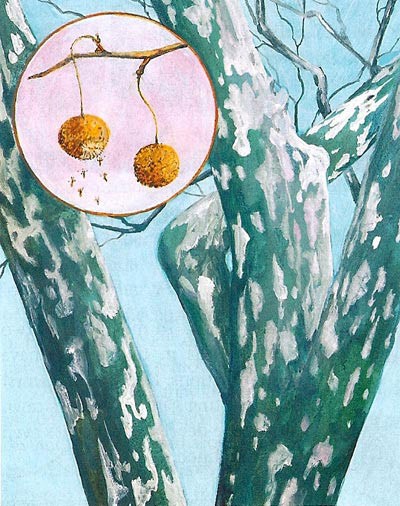
Michael Dirr, the author of my favorite horticultural book, is a rarity in that he is dubious about sycamore, which he considers to be “overplanted.” Most people love this tree without reservation. The ease of sycamore identification may be what begins the love affair, but it doesn’t end there.
In any season, the base of a sycamore trunk is brownish and ridged, and the branches are bone-white. In between is a striking, piebald trunk, which wears convoluted camouflage-like patches of white, green, and brown – very unlike any other temperate-climate tree. This curious appearance results from an inability of the bark to stretch enough to accommodate growth. Instead, bark is sloughed off as the tree grows, leaving jigsaw-like pieces on the ground and a piece of artwork rising above.
Sycamore is one of our fastest growing trees, and thus sheds many bark puzzle pieces. Although not the largest deciduous tree in North America, it is considered to be the most massive as it spreads widely and attains the largest diameter; up to a documented 13.1 feet, or 16.5 feet as legend would have it.
Because sycamore wood is susceptible to decay organisms, older trees, especially those of bygone days, are often hollow. These huge, old caverns were both utilitarian and legendary: Johnny Appleseed camped in one for a time, whole pioneer families lived in hollow sycamores while their cabins were being built, livestock were housed in them, and so on. John James Audubon described hundreds of chimney swifts settling into a hollow sycamore for the night, “like bees hurrying into their hive.”
Native Americans used the hollow trunks for dugout canoes, and the wood, though somewhat difficult to work, was used in the past for tubs, casks, wooden washing machine parts, and cisterns. One use that survives is for butchers’ blocks, where sycamore’s notorious resistance to splitting is not a defect but an essential feature.
The tree is at its best in the Ohio and Mississippi River basins and is a common pioneer species on floodplains. This pioneer defies the usual rules: it is both fast-growing and long-lived. Trees more than 250 years old are common, and some specimens live twice that long.
Sycamores are found north to southern Maine and in the Connecticut, Champlain, and Hudson valleys, often hugging the watercourses, but these northern trees don’t reach the massive proportions of their southern counterparts.
In winter, the fruits, packed into fuzzy balls about an inch in diameter, hang from long stems. They look like Christmas tree ornaments, a likeness that gives the tree another one of its names: buttonball. The fruits remain intact until late winter and are not a preferred food for wildlife, although purple finches, chickadees, juncos, muskrats, beavers, and squirrels all eat the seeds.
The leaves follow the maple format, but there the resemblance ends: they are large (from 4 to 10 inches wide), broader than long, alternate, and have downy hairs on the pale undersides.
By the 1880s, along with American elm and silver maple, sycamore was one of the most widely planted trees on town greens and city streets. All three of these bottomland species have evolved to withstand both flooding and drought, traits that serve them well when they are planted in urban environments. Our native sycamore was soon found to be susceptible to plane anthracnose disease, a fungus introduced from Europe that blackens the leaves. The London plane tree, a cross between our sycamore and Platanus orientalis, a tree from southern Europe and Turkey, was far less susceptible to disease.
The London plane tree is believed to be a natural hybrid that occurred around 1670 between two residents of a botanical garden in England. The result is a tree that is very much like sycamore but, in addition to disease resistance, is hardier and more tolerant of pollution.
Although London plane trees are common street trees today in both America and Europe, their resistance to disease and pollutants has, unfortunately, eroded. About 40 years ago, scientists at the National Arboretum deliberately replicated the hybridization that occurred spontaneously over 300 years before. From this, new cultivars have been developed – with more and better anthracnose and pollution resistance.
Urban foresters still have their reservations about any of the Platanus species because they are so large. They don’t fit in well when planted along a normal street, often taking over completely and heaving up sidewalks. But they are spectacular when planted along wide boulevards, adding more grandeur than any other kind of tree.

